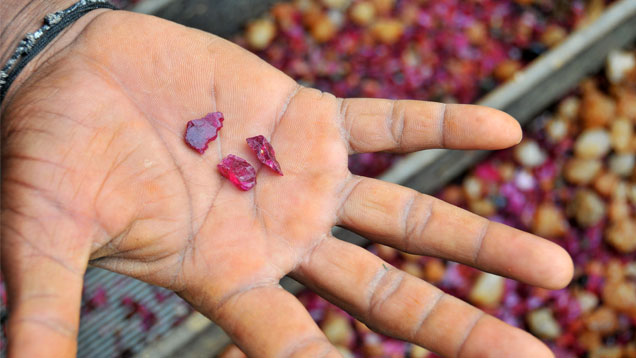Field Researchers Witness Evolution of Major Ruby Deposit in Mozambique

GIA team explores Montepuez mining operation
CARLSBAD, Calif. – Sept. 29, 2014 – In early Sept. 2014, a team of GIA (Gemological Institute of America) field researchers journeyed to the Montepuez mining area of Mozambique to collect ruby samples for the Institute’s gem identification database and to document the current state of the deposit. The Montepuez Ruby Mining Company (MRM) has rapidly expanded since the operation reached the production stage in 2012, handling 1.6 million tons of rock and recovering eight million carats of ruby and corundum to date. The GIA team, consisting of Field Gemologists Andrew Lucas and Vincent Pardieu, Gems & Gemology (G&G) Technical Editor Tao Hsu, videographer Didier Gruel and expedition guest Stanislas Detroyat, discovered an ample variety of ruby specimens ranging in size, color and iron content.This is the third expedition GIA researchers have made to the Montepuez ruby deposit since its discovery in 2009. “It is truly fascinating to witness the evolution of this major deposit. While it is clear from our expedition that the MRM operation has reached production stage, I believe that this is just the beginning. The deposit seems to be incredibly rich, easy to mine and conveniently located along a major road and close to Mozambique’s port city of Pemba,” said Pardieu.
Today, MRM employs 600 staff and consists of four pits, a sophisticated washing plant, a sorting facility using a proprietary ruby evaluation system, an extensive prospection system and a base camp. Two types of deposits are found at the operation: at Maninge Nice, rubies are found in a primary deposit associated with amphibole, mica and feldspar. In Mugloto, Ntorro and Glass, rubies are found in secondary deposits along current or former river beds. The company is currently focusing mining production on secondary deposits in the Mugloto area since it is shallow (4-8 meters) and rich in high quality clean rubies, a result of millions of years of weathering.
Even though the mine is in production, exploration continues at a fast pace, with core drilling into primary deposits and auger drilling into secondary deposits. “This deposit will not only change the supply structure of ruby on the global market, but may also contribute to changing the way business is done in the ruby trade,” added Lucas.
In keeping with its mission to ensure the public trust in gems and jewelry, GIA regularly conducts research field trips to important gem and jewelry centers around the globe, incorporating findings into research practices and education programs and providing information to the trade and public. GIA appreciates the access and information provided during these visits; however, they should not be taken as or used as a commercial endorsement. Findings from the Mozambique field trip will be featured in an upcoming G&G article, as well as field reports and video documentaries on www.gia.edu.



